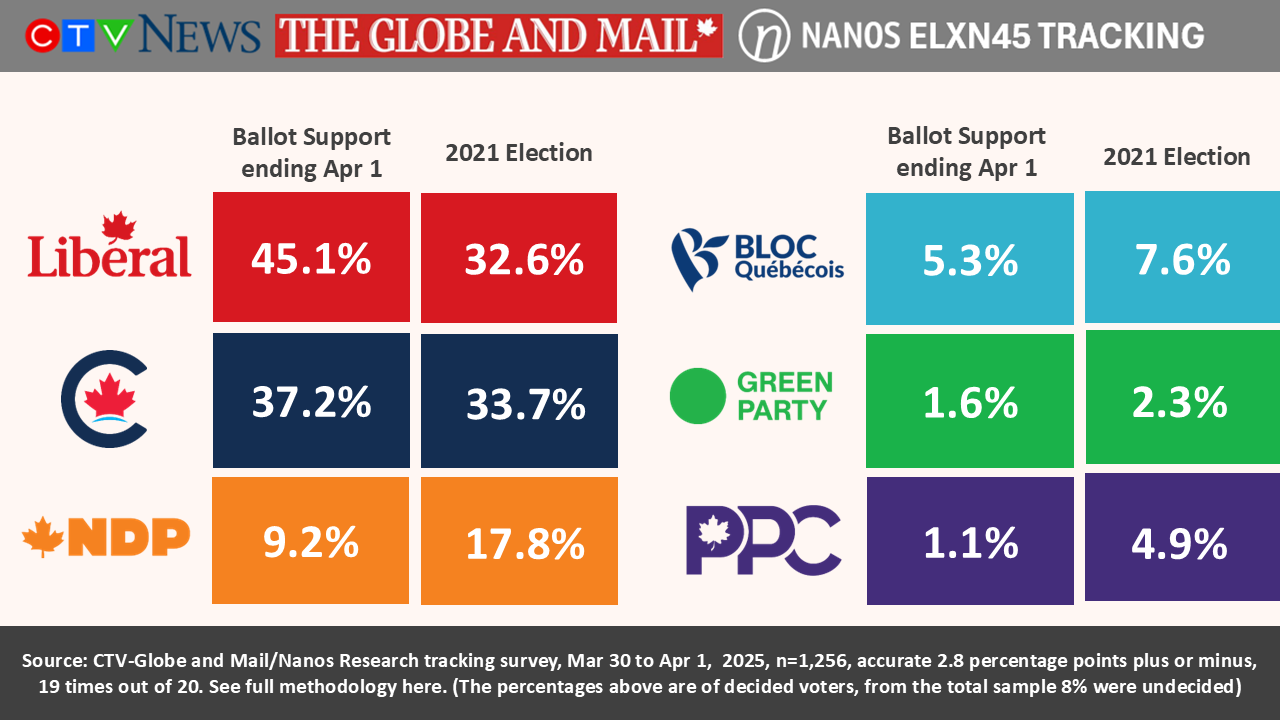Is Canada moving towards a two party system?
FEDELXN CTV News/Globe and Mail Nanos Tracking: LPC 45, CPC 37, NDP 9, BQ 5, GPC 2, PPC 1 (three nights ending Apr 1)
The Carney Liberals continue to have an eight-point advantage over the Poilievre Conservatives. Compared to past elections, a two-party consolidation is redefining the election landscape. A key signature of this election is the consolidation of support among the two front running parties. Over eight in ten voters today are voting Liberal or Conservative. This compared to about two in three in the last election.
This puts a spotlight on how non-governing parties are being squeezed by the focus on the front runners, who will deal with the US administration and guide the Canadian economy through uncertain times. (Three-day sample ending April 1, 2025)
Every night throughout the election period, Nanos Research will capture the political pulse of Canadians. Together with the seasoned journalists at CTV News and The Globe and Mail, we will be your go-to source for comprehensive campaign coverage. Here are the highlights from last night's Nanos political tracking, based on the latest three-night rolling average. For more in-depth analysis and insights, visit CTV News, The Globe and Mail or Nanos Research.
To build your own charts and access thousands of polling trend lines subscribe to the Nanos Data Portal to access federal nightly tracking, federal weekly tracking and an impressive scope of the policy, consumer confidence and public opinion trends.
Feel free to forward this email to people who may be interested in tracking the federal election.
Methodology for the Nightly Tracking
The CTV-Globe and Mail/Nanos nightly federal election tracking conducted by Nanos Research surveys 1,200 Canadians aged 18 years and over, for three days (400 interviews each day). Respondents are all randomly recruited through a dual-frame (cell- and landline RDD sample using live agents). Three quarters of the sample is administered the questionnaire by telephone and one quarter is administered the same questionnaire online. The random sample may be weighted by age and gender according to the latest Canadian census data. Throughout the election, the interviews are compiled into a three-night rolling average of 1,200 interviews, with the oldest group of 400 interviews being replaced by a new group of 400 each evening.
The current data of 1,256 interviews covers the three-night period ending April 1, 2025. A random survey of 1,256 Canadians is accurate 2.8 percentage points, plus or minus, 19 times out of 20.
The full methodology is detailed in the technical note of the report on the Nanos website. This research was conducted and released in accordance with the standards of the CRIC of which the firm is an accredited member.







